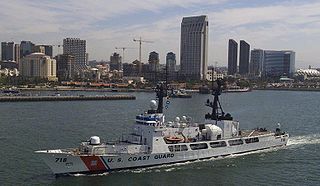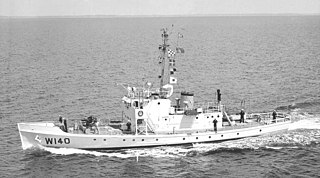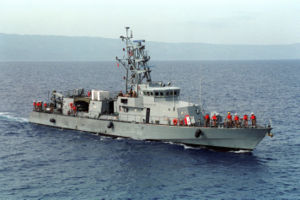The United States Navy, United States Coast Guard, and United States National Oceanic and Atmospheric Administration (NOAA) use a hull classification symbol to identify their ships by type and by individual ship within a type. The system is analogous to the pennant number system that the Royal Navy and other European and Commonwealth navies use.

USCGC Acushnet (WMEC-167) was a cutter of the United States Coast Guard, homeported in Ketchikan, Alaska. She was originally USS Shackle (ARS-9), a Diver-class rescue and salvage ship commissioned by the United States Navy for service in World War II. She was responsible for coming to the aid of stricken vessels and received three battle stars during World War II, before a long career with the Coast Guard. Acushnet patrolled the waters of the North Pacific and was one of the last World War II era ships on active duty in the US fleet upon her retirement in 2011.

USCGC Chase (WHEC-718) was a Hamilton-class High Endurance Cutter of the United States Coast Guard. She was laid down on October 26, 1966, at Avondale Shipyards in New Orleans, launched on May 20, 1967, and commissioned on March 11, 1968. Chase is the fourth of twelve Hamilton class, 378-foot (115 m) cutters, and the third cutter named in honor of Salmon Portland Chase. She was decommissioned on March 29, 2011, and transferred to the Nigerian Navy as an excess defense article under the Foreign Assistance Act as NNS Thunder (F90).

USCGC Dallas (WHEC-716) was a United States Coast Guard high endurance cutter commissioned in 1967 at the Avondale Shipyard in New Orleans, Louisiana. She was the sixth ship or boat to bear the name of Alexander J. Dallas, the Secretary of the Treasury under President James Madison (1814–1816). She is one of twelve Hamilton-class cutters built for the Coast Guard.

USS Zephyr (PC-8) is a Cyclone-class patrol coastal ship in the United States Navy.
This article covers the organization of the United States Coast Guard.

USS Firebolt (PC-10) is the 10th member of the Cyclone class of coastal patrol boats of the United States Navy. She is a 174 ft (53 m) vessel with a crew of approximately 30 sailors, normally homeported at Naval Amphibious Base Little Creek, Norfolk, Virginia. Her armament includes two Mk38 chain guns, two Mk19 automatic grenade launchers, and two .50 in (12.7 mm) machine guns, as well as six Stinger missiles. She was laid down by Bollinger Shipyards on 17 September 1993, launched on 10 June 1994, commissioned into the Navy on 10 June 1995, and she was decommissioned on 23 February 2022.

USS Cyclone (PC-1) was the first of the Navy's Cyclone-class coastal patrol ships. As the lead ship of her class, Cyclone served as the test bed for this series of 14 vessels.

The Cyclone-class patrol ships are a class of coastal patrol boats, formerly in service with the United States Navy. Most of these ships, named for weather phenomenae, were launched between 1992 and 1994. The primary mission of these ships is coastal patrol and interdiction surveillance, an important aspect of littoral operations outlined in the Navy's strategy, "Forward...From the Sea." These ships also provided full mission support for U.S. Navy SEALs and other special operations forces. Several ships of the class were transferred to the U.S. Coast Guard (USCG) for a time and then later returned.

USS Hurricane (PC-3) is the third of the Cyclone-class of United States Navy coastal patrol ships, named for various weather phenomena.

USS Monsoon (PC-4) is the fourth Cyclone-class patrol ship. Monsoon was laid down by Bollinger Shipyards, Lockport, Louisiana on 15 February 1992 and launched 10 October 1992. She was commissioned 22 January 1994 by the United States Navy. She was decommissioned 1 October 2004 and loaned to the United States Coast Guard as USCGC Monsoon (WPC-4). She was returned to the U.S. Navy on 22 August 2008, and decommissioned again on 28 March 2023.

USS Tornado (PC-14) is the fourteenth and last Cyclone-class patrol ships, notable for being the only ship in the class designed with shaping features for signature management. She was laid down by Bollinger Shipyards, Lockport, Louisiana 25 August 1998 and launched 7 June 1999. She was commissioned by the United States Navy 24 June 2000, decommissioned 1 October 2004 and transferred to the United States Coast Guard as USCGC Tornado (WPC-14).

USS Seize (ARS-26) was a Diver-class rescue and salvage ship commissioned in the United States Navy during World War II. Her task was to come to the aid of stricken vessels.

The third USS Calypso (AG-35) was launched 6 January 1932 for the United States Coast Guard as USCGC Calypso (WPC-104) by the Bath Iron Works in Bath, Maine. She was initially stationed at San Diego, California, and transferred to Baltimore, Maryland in 1938. She was transferred from the Coast Guard to the U.S. Navy on 17 May 1941 and commissioned the same day.

The Ukrainian patrol vessel Sloviansk (P190) was an Island-class patrol boat of the Naval Forces of the Armed Forces of Ukraine. Originally named USCGC Cushing when in service with the United States Coast Guard, the vessel was acquired by Ukraine in 2018 and arrived in Ukraine on 21 October 2019. Sloviansk was sunk in combat on 3 March 2022 by a Russian air-to-surface missile.

USCGC Adak (WPB-1333) was a United States Coast Guard cutter that received her name from Adak Island in the Aleutian Islands of Alaska. Built at Bollinger Shipyard in Lockport, Louisiana, Adak was placed in commission on 18 August 1989 in New Jersey and decommissioned on 30 June 2021 in Manama, Bahrain after almost 32 years of service.

The Active-class patrol boat was one of the most useful and long-lasting classes of United States Coast Guard cutters. Of the 35 built in the 1920s, 16 were still in service during the 1960s. The last to be decommissioned from active service was the Morris in 1970; the last in actual service was the Cuyahoga, which sank after an accidental collision in 1978.

USCGC Maui (WPB-1304) was a United States Coast Guard Island-class patrol boat homeported in Manama, Bahrain. She was named after the second-largest of the Hawaiian Islands, Maui.
USCGC Aurora (WPC-103) was a 165-foot (50 m), steel-hulled, diesel-powered Thetis-class patrol boat of the United States Coast Guard.

The BRP Valentin Diaz (PS-177) is an Alvarez-class patrol ship of the Philippine Navy. She is the Philippine Navy's second ship of the class and was a Cyclone-class patrol ship previously named USS Monsoon (PC-4) during her service with the US Navy.



















